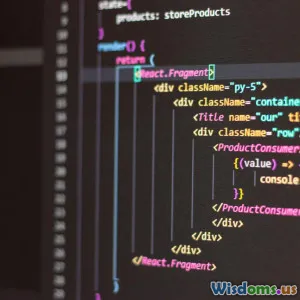
How to Fix Performance Bottlenecks in React Applications
8 min read Unlock the secrets to optimizing your React apps by identifying and fixing common performance bottlenecks efficiently. (0 Reviews)
How to Fix Performance Bottlenecks in React Applications
React.js has revolutionized frontend development by making it straightforward to build dynamic user interfaces. However, as React applications grow in complexity, performance issues can arise, leading to sluggish user experiences and frustrated users. Understanding and fixing performance bottlenecks in React is critical to developing fast, scalable, and resilient apps.
Introduction
Imagine scrolling through a React app that lags or reacts slowly to clicks. Users quickly abandon apps that feel slow or clunky—this can mean lost revenue and damaged brand reputation. Tackling performance issues early and with precision ensures your app remains responsive, enjoyable, and competitive.
This article dissects the most common performance bottlenecks in React apps and offers proven tactics to diagnose and fix them. Whether you're a junior developer or a seasoned engineer, these insights will empower you to build lightning-fast React applications.
Understanding Performance Bottlenecks in React
Performance bottlenecks are areas in your app where render cycles, computations, or resource usage slow down execution. React’s declarative approach can sometimes unintentionally cause excess re-renders or heavy computations. Recognizing these pitfalls lays the foundation to optimize your app.
Key sources of bottlenecks include:
- Excessive re-rendering due to improperly managed state or props
- Heavy computations inside render or lifecycle methods
- Unoptimized component trees leading to unnecessary DOM manipulations
- Inefficient resource loading and heavy bundle sizes
How to Identify React Performance Bottlenecks
Before fixing, you must measure and identify performance issues accurately.
React DevTools Profiler
The React DevTools Profiler allows developers to record React component render durations and identify slow components visually. It provides:
- Flamegraphs showing render times
- Commit overview
- Warnings on unnecessary re-renders
Chrome DevTools Performance Tab
Use the browser's Performance panel to analyze JavaScript execution, frame rates, memory usage, and layout thrashing outside React context.
Why Did You Render?
An open-source library that logs unnecessary re-renders and helps detect problematic components by comparing props and state changes.
Real-World Insights
Airbnb, known for a complex React app, uses profiling tools continuously. Kyle Mathews from Gatsby emphasizes: “Measuring performance with real users, in real devices, is key to finding issues we wouldn't detect just by code review.”
Tactics to Fix Performance Bottlenecks
1. Optimize Component Re-rendering
Use React.memo
Wrapping functional components with React.memo memoizes the component, preventing re-renders if props do not change. This is especially helpful in list rendering or when parent states update frequently.
const MyComponent = React.memo(({data}) => {
// render logic
});
Leverage useCallback and useMemo
useCallbackmemoizes functions to prevent them from being re-created unnecessarily, which can cause children to re-render.useMemocaches expensive computations during render.
Example:
const expensiveValue = useMemo(() => computeHeavy(data), [data]);
const handleClick = useCallback(() => setCount(c => c + 1), []);
2. Code Splitting & Lazy Loading
Sending a huge bundle at once increases load time drastically.
Use React’s lazy and Suspense to split components and load them only when needed.
const LazyComponent = React.lazy(() => import('./LazyComponent'));
<Suspense fallback={<div>Loading...</div>}>
<LazyComponent />
</Suspense>
Tools like Webpack and Vite help implement this efficiently.
3. Avoid Index as Key in Lists
Using array indexes as keys can cause improper reconciliation leading to unnecessary DOM updates.
Always use unique stable identifiers to help React track list items.
4. Minimize Expensive Operations in Render
Move heavy calculations or data transformations outside of the render path, or cache results using useMemo.
5. Manage State Wisely
Lift state up selectively
Avoid global app state updates causing large tree re-renders. Use local state or slicing strategies via Redux or Zustand.
Use Immutable Data Structures
Immutable updates make shallow comparison fast and more efficient for shouldComponentUpdate or memoization.
6. Utilize shouldComponentUpdate and PureComponent
In class components, override shouldComponentUpdate to control re-renders or extend PureComponent to benefit from shallow prop comparison.
7. Debounce and Throttle Event Handlers
For event-heavy interactions like typing or scroll, debouncing or throttling callbacks reduces render frequency and improves UX.
Example using lodash.debounce:
const debouncedSave = useCallback(debounce(value => save(value), 500), []);
8. Optimize Images & Assets
Large images cause the main thread to choke. Employ modern formats (WebP), lazy load images (<img loading="lazy" />) and use optimized assets.
9. Server-Side Rendering (SSR) & Static Site Generation (SSG)
For initial load speed, SSR or SSG can significantly improve the Time To Interactive (TTI). Frameworks like Next.js provide these features out of the box.
Example Case Study
A real estate listing React app was experiencing lags during heavy search filters updates. Profiling revealed entire lists re-rendered on every keystroke in search inputs. The fixes included:
- Memoizing list item components with
React.memo - Using
useCallbackfor event handlers - Debouncing search input state updates
- Implementing lazy-loading images in property cards
Post-optimization, the app reported 40% faster renders with smoother scrolling, improved user retention, and higher engagement.
Conclusion
Performance bottlenecks in React applications often stem from excessive re-renders, unoptimized computations, and heavy assets. Identifying bottlenecks via React Profiler and optimizing them through memoization, code splitting, and efficient state management pays dividends in user experience and app scalability.
By adopting these strategies early and continuously monitoring, developers can ensure React apps not only work but delight users with speed and responsiveness. As React continues evolving, staying proactive on performance will keep your apps competitive in today’s fast-paced web.
Take Action: Start by profiling your application today. Measure your bottlenecks, apply the techniques shared here, and watch your React app transform into a high-performance masterpiece.
Rate the Post
User Reviews
Popular Posts


















